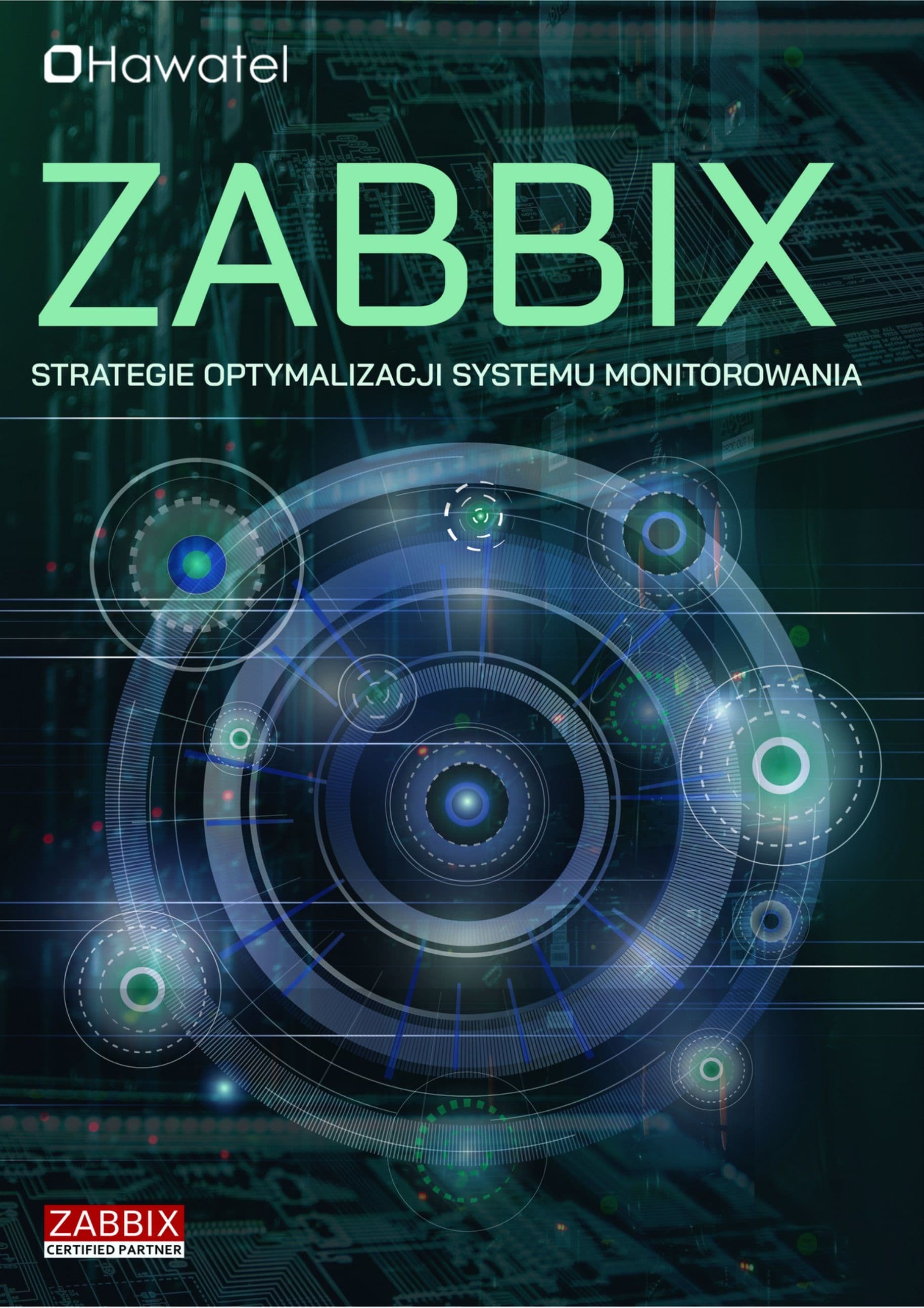Welcome to Hawatel's blog!
September 23, 2025 | Infrastructure management / Monitoring / General / Software
Zabbix implementation – A comprehensive step-by-step guide [2025]
IT infrastructure monitoring is now essential in every organization, regardless of its size. Companies need full control over servers, networks, applications, and cloud services. In this context, Zabbix is one of the most popular and most flexible solutions available on the market.
Zabbix is an open-source IT monitoring platform that allows you in real time to:
- monitor the availability and performance of devices,
- detect problems before they become failures,
- generate notifications and reports,
- automate responses to defined events.

Why do companies choose Zabbix?
Zabbix does not involve licensing costs, as it is an open-source product. The platform is extremely scalable – it works well for monitoring just a few servers in a small company as well as thousands of devices in a global infrastructure. It offers broad integration possibilities, working with Linux and Windows systems, databases, network devices, business applications, and public clouds such as AWS, Azure, and Google Cloud Platform. An additional advantage is the active development of the project, supported by a large user community and extensive documentation. Implementing Zabbix is an investment that pays off quickly and reduces the costs of commercial licensing.

Source: Zabbix
Why is professional Zabbix implementation important?
In theory, Zabbix can be installed independently using available tutorials. In practice, however, many companies encounter problems:
- Incorrectly designed architecture – the environment is not prepared for growth from the start.
- Suboptimal monitoring configuration – the system works but does not use its full potential.
- Improper performance settings – the server and database are overloaded instead of being optimized.
- Lack of configuration standardization – inconsistent approaches to hosts introduce chaos and hinder management.
- No automation – manually adding hosts and rules increases the risk of errors and wastes time.
- Misconfigured alerts – a flood of false notifications instead of real support.
- No integration with business systems – monitoring operates in isolation from company processes.
- Scaling issues – infrastructure growth forces costly rebuilds.
A professional Zabbix implementation by experienced engineers resolves all the most common issues related to system configuration and maintenance. Experts can analyze the organization’s business and technical needs and then design an optimal architecture tailored to its environment. Monitoring is configured to generate only relevant alerts, avoiding an overload of unnecessary notifications. In addition, dashboards are prepared and customized for different roles in the organization – different for administrators, managers, or executives. The entire process is complemented by team training and post-implementation support. The result is a system that truly works, supports company growth, and does not become another source of problems.

Source: Zabbix
Stages of Zabbix implementation in a company
The first step in every implementation is a thorough analysis of the client’s environment and needs. Hawatel specialists conduct an inventory of physical and virtual servers, operating systems (Linux, Windows, BSD), databases (MySQL, PostgreSQL, Oracle, MS SQL), network devices, business applications, and cloud solutions. Based on this, monitoring goals are defined – for example, ensuring the continuity of e-commerce applications, controlling the performance of financial services, or enhancing corporate network security.
The second stage is the installation and configuration of Zabbix. At this stage, the appropriate architecture is selected:
- on-premise, i.e., installation on the client’s servers,
- cloud, i.e., implementation in a private or public cloud,
- hybrid, combining both approaches.
Once the server is launched, monitoring agents are configured to collect data from hosts. Depending on needs, different methods are used, such as SNMP, IPMI, JMX, or agentless monitoring based on HTTP, SSH, or ICMP protocols.
The next step is integrations and extensions. Zabbix connects with other systems and tools to provide a full picture of the infrastructure. This includes monitoring Windows and Linux systems, integration with AWS CloudWatch, Azure Monitor, or Google Cloud Operations, as well as support for network devices from Cisco, Juniper, Mikrotik, Ubiquiti, or Fortinet. The system can also be linked to databases and corporate applications such as ERP or CRM.
The fourth stage is configuring dashboards, alerts, and automation. Zabbix allows dashboards to be tailored to different roles in the organization – from administrators who need detailed parameters to managers who expect a general overview of infrastructure health. An important element here is defining warning and critical thresholds and setting notification methods (e.g., email, SMS, Slack, Teams). Additionally, automated actions are implemented, such as restarting services in case of failure.

Source: Zabbix
Finally, testing and optimization are carried out. This stage includes load tests to verify system performance, failure simulations to check monitoring responses, adjustments to alerting rules, preparation of documentation, and IT team training.
Case studies – Zabbix implementations in practice
Below we present examples of implementations carried out by our team at Hawatel. These are real projects in which we helped our clients successfully transition to Zabbix and build a stable, modern IT monitoring system.

Migration from Nagios to Zabbix in a Polish telecommunications company
Migrating from the outdated Nagios system to the modern Zabbix platform allowed a Polish telecom company to streamline IT infrastructure monitoring, improve performance, and reduce maintenance costs.
Challenge
The company had been using Nagios for over a decade to monitor hundreds of servers and dozens of systems and databases. However, the tool was burdened with technical debt – community support was lacking, and maintaining custom scripts was becoming increasingly problematic. The organization wanted to move to Zabbix to unify monitoring within a single platform. Key challenges included:
- migration from Nagios to Zabbix without disruptions to system availability,
- eliminating dependencies on custom scripts,
- improving performance and data visualization,
- training the IT team.
Solution
The migration took four months. First, a detailed audit of the Nagios system and an inventory of monitored elements were conducted. The configuration was then replicated in Zabbix, replacing custom scripts with native mechanisms. The implementation was carried out gradually to maintain monitoring continuity. Modern dashboards were prepared, and IT team training was conducted.
Results
- improved monitoring availability and performance,
- anomaly alerts implemented,
- elimination of technical debt and outdated scripts,
- modern Zabbix dashboards,
- monitoring system standardization,
- reduced maintenance costs,
- enhanced IT team competencies.

Zabbix implementation in a retail chain
In the dynamic retail environment, a large server infrastructure is crucial for service stability. Our client, the owner of a retail chain, needed effective monitoring of a large, distributed server environment spanning two data centers.
Challenge
The company was using a commercial monitoring tool covering system, hardware, database, and application layers. The client was looking for a more flexible and less costly solution that would allow further development of functionalities.
Solution
We proposed the implementation of open-source technology – Zabbix as the core monitoring system and Grafana as the data visualization tool. The project included:
- migration of monitoring for about 1,000 servers and network devices,
- monitoring of storage arrays (IBM, Hitachi, NetApp),
- monitoring of Microsoft services (Active Directory, IIS, Exchange, File Server, RDS),
- integration with HPE OneView, IBM Storage, and VMware,
- flexible email and SMS notification system,
- about 40 dedicated dashboards in Grafana.
Results
- complete migration from the commercial system to Zabbix within four months,
- extended monitoring functionality compared to the previous solution,
- flexible notifications and advanced dashboards,
- lower maintenance costs and greater system control.
Why choose Hawatel for Zabbix implementation?
- Zabbix Certified Partner – we hold official Zabbix partner status, confirming our expertise and direct access to vendor support.
- Experience – we have completed many implementation projects in both the private and public sectors.
- Comprehensive approach – from needs analysis, through installation and configuration, to training and post-implementation support.
- Flexibility – we adapt Zabbix to different environments (on-premise, cloud, hybrid).
- 24/7 support – we provide continuous system support.

FAQ – Frequently Asked Questions
How long does Zabbix implementation take?
- Depending on the project scale – from a few days (for small companies) to several weeks for large environments.
Can Zabbix work in the cloud?
- Yes. Zabbix supports AWS, Azure, and Google Cloud, enabling monitoring of both cloud instances and SaaS applications.
What are the hardware requirements?
- For small implementations, a server with 4 CPUs, 8 GB RAM, and an SSD is sufficient. For large environments, clustered architecture and a dedicated database are recommended.
Is it possible to customize dashboards for different departments?
- Yes. Zabbix allows personalization of views for administrators, managers, and executives.

Summary
Professional Zabbix implementation is the key to full control over IT infrastructure. Thanks to it, companies can detect failures faster, avoid downtime, and optimize system maintenance costs.
As a Zabbix Certified Partner, Hawatel provides full support – from needs analysis through implementation to system maintenance and development. Contact us and learn how we can help your company achieve effective IT monitoring.







